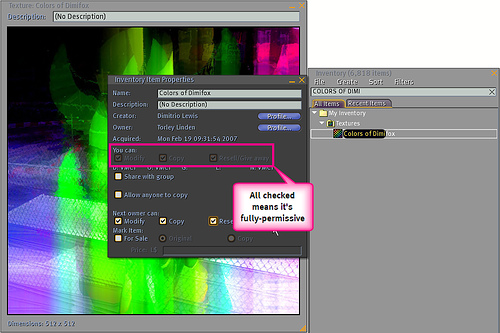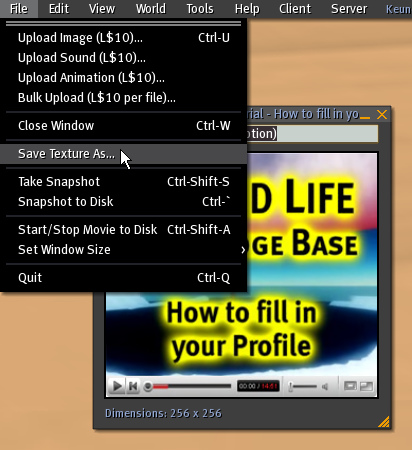Difference between revisions of "Project:Flagged Revs Backup/How to save textures to your hard drive"
Fritz Linden (talk | contribs) (Initial Parature import) |
Yoz Linden (talk | contribs) m (1 revision) |
||
| Line 1: | Line 1: | ||
{{Seal}} | {{Seal}} | ||
'''You can export any fully-permissive texture from Second Life and save it to your hard drive (or other storage medium).''' | '''You can export any fully-permissive texture from Second Life and save it to your hard drive (or other storage medium).''' | ||
By fully-permissive, this means you must have ALL "Modify", "Copy", and "Resell/Give away" (transfer) rights for the texture. You can check this by right-clicking a texture in your inventory and selecting Properties. | By fully-permissive, this means you must have ALL "Modify", "Copy", and "Resell/Give away" (transfer) rights for the texture. You can check this by right-clicking a texture in your inventory and selecting Properties. | ||
Example of a fully-permissive texture: | Example of a fully-permissive texture: | ||
[[Image:kb_texture_check_permissions.jpg]] | [[Image:kb_texture_check_permissions.jpg]] | ||
By default, textures you upload yourself, whether it's via '''File menu > Upload Image''' or the '''Snapshot button > "Upload a snapshot"''', will be fully-permissive for you. | By default, textures you upload yourself, whether it's via '''File menu > Upload Image''' or the '''Snapshot button > "Upload a snapshot"''', will be fully-permissive for you. | ||
So here's how to do it: | So here's how to do it: | ||
[[Image:kb_save_texture_as.jpg]] | [[Image:kb_save_texture_as.jpg]] | ||
* Double-click the texture in inventory to view it. | * Double-click the texture in inventory to view it. | ||
| Line 18: | Line 25: | ||
* Give it a name (it doesn't auto-copy the name of the texture), and save it to a directory. | * Give it a name (it doesn't auto-copy the name of the texture), and save it to a directory. | ||
In any case, once the texture's on your local disk, you're free to edit it, and then re-upload it back into Second Life if you want. You can upload them to a photo-sharing website like | If you go to that directory on your computer, you should see a "texture.tga" file. TGA stands for the Targa file format, which can also be used to upload textures into Second Life. Most graphics editors are capable of viewing TGA, and there are some free ones, like XnView, which can convert into other formats too. | ||
In any case, once the texture's on your local disk, you're free to edit it, and then re-upload it back into Second Life if you want. You can upload them to a photo-sharing website like Flickr, which has both a Resident-run and a Linden-run Linden Village group. | |||
'''Why are there two icons for textures?'''Good question! For all practical purposes, they function the same, but the icon denotes how the texture got into Second Life. If you use '''File menu > Upload Image''', the resulting texture has this icon and ends up in the Textures folder: | '''Why are there two icons for textures?'''Good question! For all practical purposes, they function the same, but the icon denotes how the texture got into Second Life. If you use '''File menu > Upload Image''', the resulting texture has this icon and ends up in the Textures folder: | ||
[[Image:kb_inventory_texture_icon.jpg]] | [[Image:kb_inventory_texture_icon.jpg]] | ||
And if you take an inworld snapshot ('''Snapshot button > "Upload a snapshot''', then click '''Upload'''), the resulting texture has this icon and ends up in the Photo Album folder: | And if you take an inworld snapshot ('''Snapshot button > "Upload a snapshot''', then click '''Upload'''), the resulting texture has this icon and ends up in the Photo Album folder: | ||
[[Image:kb_inventory_snapshot_icon.jpg]] | [[Image:kb_inventory_snapshot_icon.jpg]] | ||
One other difference is, if someone else sends you a snapshot with the latter icon, it'll end up in the Textures folder. | One other difference is, if someone else sends you a snapshot with the latter icon, it'll end up in the Textures folder. | ||
We know this "different icons for essentially what's the same item type" is confusing to some, and perhaps in the future, it can be improved. | We know this "different icons for essentially what's the same item type" is confusing to some, and perhaps in the future, it can be improved. | ||
'''How do I batch save textures to my hard drive?''' A common example of this is when someone has accumulated many months (or even years) of Second Life memories, and wants to save all their photos to their hard drive. | '''How do I batch save textures to my hard drive?''' A common example of this is when someone has accumulated many months (or even years) of Second Life memories, and wants to save all their photos to their hard drive. | ||
Unfortunately, there is no way to do this at present; textures must be saved one at a time, and named accordingly. | Unfortunately, there is no way to do this at present; textures must be saved one at a time, and named accordingly. | ||
Revision as of 16:29, 5 October 2009

This article is part of the Extended Second Life Knowledge Base that includes advanced and specialized information. This information was originally provided by Linden Lab, but is not actively maintained nor guaranteed to be accurate. Linden Lab does not certify nor assume any responsibility for this information.
See the official Second Life Knowledge Base for the most current information.
You can export any fully-permissive texture from Second Life and save it to your hard drive (or other storage medium).
By fully-permissive, this means you must have ALL "Modify", "Copy", and "Resell/Give away" (transfer) rights for the texture. You can check this by right-clicking a texture in your inventory and selecting Properties.
Example of a fully-permissive texture:
By default, textures you upload yourself, whether it's via File menu > Upload Image or the Snapshot button > "Upload a snapshot", will be fully-permissive for you.
So here's how to do it:
- Double-click the texture in inventory to view it.
- Go to File menu > Save Texture As.
- Give it a name (it doesn't auto-copy the name of the texture), and save it to a directory.
If you go to that directory on your computer, you should see a "texture.tga" file. TGA stands for the Targa file format, which can also be used to upload textures into Second Life. Most graphics editors are capable of viewing TGA, and there are some free ones, like XnView, which can convert into other formats too.
In any case, once the texture's on your local disk, you're free to edit it, and then re-upload it back into Second Life if you want. You can upload them to a photo-sharing website like Flickr, which has both a Resident-run and a Linden-run Linden Village group.
Why are there two icons for textures?Good question! For all practical purposes, they function the same, but the icon denotes how the texture got into Second Life. If you use File menu > Upload Image, the resulting texture has this icon and ends up in the Textures folder:
And if you take an inworld snapshot (Snapshot button > "Upload a snapshot, then click Upload), the resulting texture has this icon and ends up in the Photo Album folder:
One other difference is, if someone else sends you a snapshot with the latter icon, it'll end up in the Textures folder.
We know this "different icons for essentially what's the same item type" is confusing to some, and perhaps in the future, it can be improved.
How do I batch save textures to my hard drive? A common example of this is when someone has accumulated many months (or even years) of Second Life memories, and wants to save all their photos to their hard drive.
Unfortunately, there is no way to do this at present; textures must be saved one at a time, and named accordingly.

